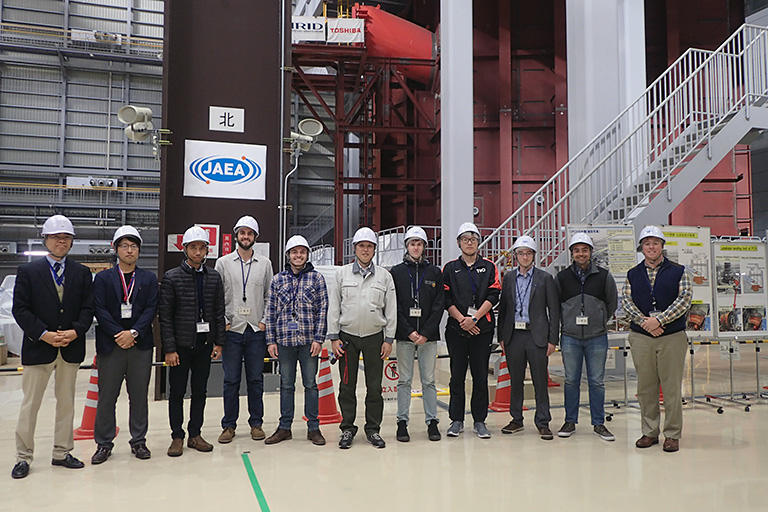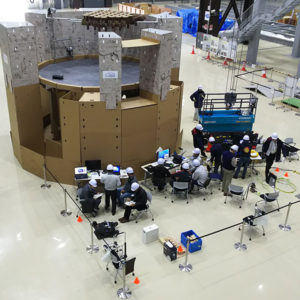
Micah Folsom, second from the right, with a group of researchers at the Naraha Center.
Nuclear engineering doctoral student Micah Folsom was one of two UT engineering students to visit the newly reopened Fukushima Daiichi plant in Japan that experienced meltdowns in three of its reactors after a devastating tsunami in 2011.
The disaster was the most significant since the 1986 Chernobyl meltdown and was listed as a Level 7 event classification on the International Nuclear Event Scale.
The purpose of the trip was to attend the NEST CLADS workshop to learn about the technologies used to decommission the reactors there, including the use of remotely controlled robots, radiation sensors, and radiation-hardened electronics.
Folsom and Logan McNeil, a doctoral student from UT’s Department of Mechanical, Aerospace, and Biomedical Engineering (MABE), attended with MABE Professor Bill Hamel, an invited speaker. They were able to attend thanks to financial support from the Japan Atomic Energy Agency (JAEA).
“During the workshop, we heard detailed presentations about the site recovery and the expanse of remaining technical challenges Japan faces in returning the environment as close as possible to its original condition,” said Hamel. “The key technical challenge at this point is reactor fuel debris removal from the reactors that experienced meltdown conditions. I am very pleased to report that my Japanese colleagues spoke very highly of our students and their abilities. They represented TCE extremely well.”
The group also included two students each from the University of California at Berkeley, McMaster University in Canada, and the University of Tokyo.
The conference was hosted through the University of Tokyo’s Nuclear Education, Skills, and Technology (NEST) program run out of the Collaborative Laboratories for Advanced Decommissioning Science (CLADS) group.
The conference started on November 26, 2018, with two days of talks by experts discussing challenges faced in these state-of-the-art technology spaces. Industry representatives shared some developing technologies, such as using virtual reality to see from the remotely controlled robot’s perspective.
The third day included a tour of the Fukushima Daiichi nuclear power plant site by the Tokyo Electric Power Company (TEPCO), which took them on a bus through the town of Ōkuma to the power station where they got to see the reactor buildings up close. The students also saw the impressive infrastructure built for the clean-up effort, including massive arrays of water tanks holding contaminated water.
The remainder of that week was spent at JAEA’s Naraha Center for Remote Control Technology Development. There, groups of students did hands-on exercises with robots to learn how to combine robots, cameras, algorithms, and radiation sensors to build 3D models and radiation maps of the inside of the reactor buildings.
—Micah Folsom
The second week was spent at the University of Tokyo campus working with students from their nuclear department on using software to perform the 3D scene reconstruction and radiation transport simulations. At the end of the week, the groups of students gave presentations on the different 3D scene reconstruction technologies they used, where they were able to share their experiences learning the process.
Folsom’s experience at Fukushima was enlightening and inspiring, reminding him of the work that remains to be done in his field.
“The decommissioning effort there will continue for decades, and I hope I have a chance to contribute in the future,” said Folsom. “It was also a very stark reminder of the uphill battle nuclear technology faces in terms of public relations both in Japan and in the US, providing a strong motivator to continue my nuclear advocacy work.”
Learn more about their trip in a WBIR story, which aired March 11, 2019 in recognition of the eighth anniversary of the Fukushima meltdown.
Contact
Élan Young: elan@tennessee.edu
